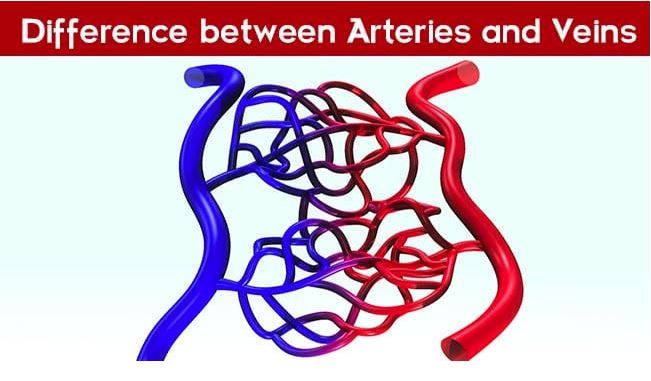What is Difference Between Arteries and Veins?
The Main Difference between Arteries and Veins is that A vein is a conduit or blood vessel whose function is to conduct deoxygenated blood from the blood capillaries to the heart. An artery is each of the vessels through which oxygenated blood flows from the heart to the capillaries of the body.

The circulatory system is designed to fulfill multiple functions, the main one is to transport blood throughout our body with the help of veins and arteries. Despite working in the same process, they work differently and have unique characteristics.
Humans have more veins, located in positions that vary depending on the person, unlike the arteries.
In the systemic or greater circulation, the arteries carry blood abundant in oxygen and scarce in carbon dioxide. While the veins carry blood rich in carbon dioxide and low in oxygen, directed towards the organs responsible for discarding it, such as the lungs, kidneys or liver.
The veins and arteries have three layers that are internal or intimate, middle or muscular and external or adventitious.
Difference Between Arteries and Veins in Tabular Form
|
Veins |
Arteries |
||
| Definition: | Ducts that carry blood from the capillaries to the heart. | Blood vessels that carry blood from the heart to the rest of the body. | |
| Functions: | Conduct deoxygenated blood through the body. | Transport the oxygenated blood. | |
| Internal valves: | Present | Missing | |
| Structure: | Scarce muscular layer, its walls are thinner and superficial. | Thicker, tough and flexible muscular layer. | |
| Blood characteristics: | The blood they carry is dark in color because it has no oxygen. | The blood that circulates in them is a lighter color because it is oxygenated. | |
| Graphic representation: | The color blue is used to avoid confusion with the arteries. | They are represented with the color red. | |
| Examples: |
|
|
|
Veins are high-capacity blood vessels that carry deoxygenated blood from the body’s capillaries to the heart. This blood that is transported is reoxygenated when it passes through the lungs.
What are veins?
The veins generally have more irregular shapes and larger than the corresponding arteries, contain approximately 70% of the total blood volume. In contrast, they are thinner walls so they collapse more quickly when pressed.
There are also veins, such as the lungs, that contain oxygenated blood that is carried to the heart and then to the rest of the body thanks to the umbilical veins and the aortic artery.
In the pulmonary circulation or minor circulation, the arteries carry insufficient oxygen blood from the heart to the lungs, and the pulmonary veins transport the oxygenated blood from the lungs to the heart.
Both blood samples and the supply of medications and nutrients are made through the veins.
Generally, the veins are associated with arteries of the same name.
What are arteries?
The arteries are the vessels that carry oxygenated blood from the heart to the capillaries of the body.
Arteries are blood vessels with thicker walls than veins, so they are firmer. They conduct blood that has been previously oxygenated in the lungs from the heart to the tissues with increased pressure during systole.
The farther away the arteries of the heart are, their layer loses their elastic fibers, and these pass from being elastic arteries to being known as muscular or distribution arteries.
As the heart pumps the blood discontinuously after an artery is distended by the flow carried by the ventricular systole, its elastic nature creates a contraction of its wall, this is known as diastolic pressure. This process allows the uninterrupted flow of blood to the tissues, which does not occur in ventricular diastole.
The primary functions of the arteries are to deliver oxygen and nutrients to all cells, remove both carbon dioxide and waste products and maintain physiological pH.
The arteries, having the highest pressure in the circulatory system, produce the pulse where the cardiac activity is reflected.
You May Also Interested:
